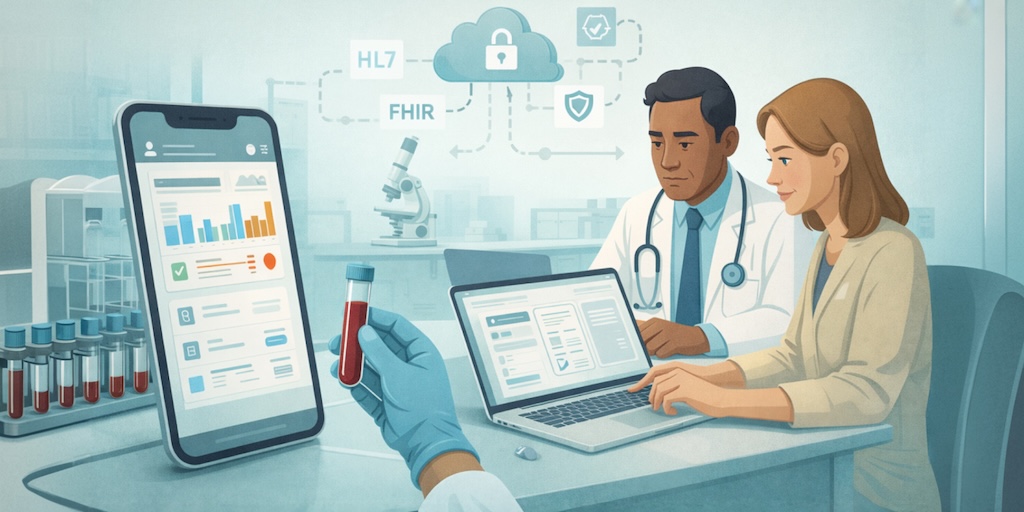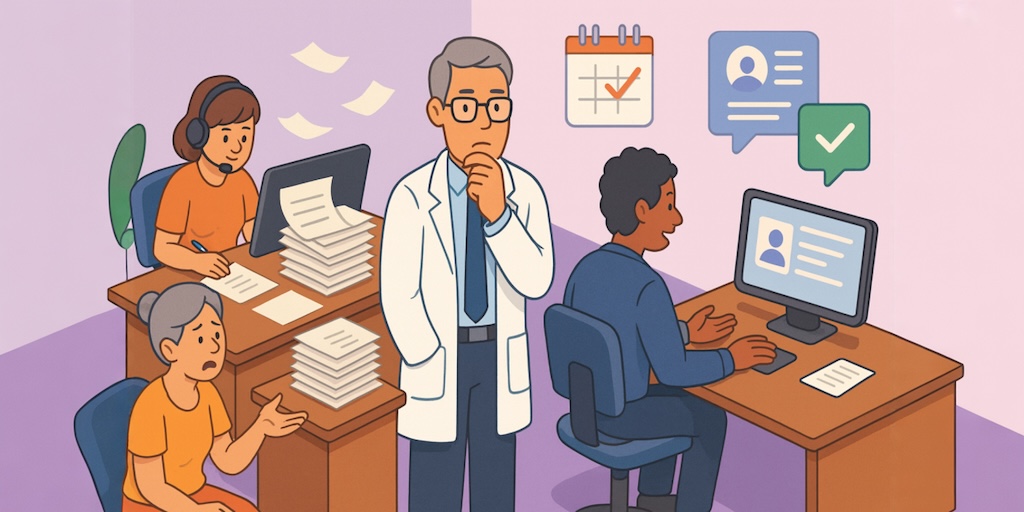Doctor On-Demand App Development: Key Features, Process, and Cost
Remember the last time you sat in a germ-fest waiting room flipping through a 2017 People magazine? Same. That relic is circling the drain, and doctor on demand app development is the double-tap that finally sends it down.
Investors are shoveling cash into telehealth faster than TikTok can birth a new dance craze, while regulators weave reimbursement parity into law. Patients, especially Gen Z, now treat “Download App” as step one of getting care.
In other words: if your virtual-care play isn’t live, compliant, and friction-free by Q4, you’re already the Blockbuster of healthcare. Here’s the roadmap to stay Netflix.
Key Takeaways
- Speed wins: With on demand doctor application development distilled into an 8-week, component-based sprint, you can hit the market while competitors are still debating wireframes.
- Future-proof from day one: In doctor on demand mobile app development, a HIPAA-ready healthcare AI builder plus a rock-solid compliance backbone means no panicked retrofits when HIPAA or state laws shift.
- Scale without burnout: Pre-built modules slash engineering toil, letting clinicians deliver care—instead of clicking through shadow EHRs—so your platform grows healthy margins and happy providers in tandem.
Market Pulse 2025: Why Doctor On-Demand App Development Still Dominates Virtual Care
Picture the post-COVID boom as a passing sugar high? Guess again—on-demand care is now hard-wired into healthcare’s metabolism. What follows is a quick CT-scan of the money, policy, and utilization signals that prove “wait-in-line” medicine is the real relic.

The Market Refuses to Chill
Global spend on telemedicine hit ≈ $158B in 2024 and is tracking a 22% CAGR toward a trillion-dollar finish line by 2034; the U.S. alone is marching from $60B to nearly half-a-trillion in the same window. Investors have noticed: digital-health startups offering the best doctor on demand app development solutions soaked up $6.4B in H1 2025, with AI-first plays snagging 62% of that cash—and commanding an 83% valuation premium for their trouble.
Utilization Hasn’t Cratered Post-Lockdown; It’s Matured
Primary-care virtual consultations now settle at a steady 6-7% of monthly visits (down from the 2020 panic peak, but still 10× pre-COVID). Mental-health demand is downright voracious—47% of all tele-visits, rising to 58% in 2023—while RPM enrollments have quadrupled since 2021.
When patients can book a video chat that happens 21 minutes faster than an in-person wait at urgent care, they vote with their thumbs.
Follow the Money—and The Policy
Congress locked in Medicare coverage through at least Sept 2025, 44 states now enforce payment parity, and private payers are falling over themselves to reimburse virtual behavioral health. Result: 11 nine-figure deals already closed this year, with AI triage vendor Abridge pulling a cool half-billion across two rounds. (Try doing that for an on-prem EHR bolt-on.)
Supply-Demand Imbalance Keeps the Flywheel Spinning
The U.S. faces an 86k-doctor shortfall by 2036, and average wait times just blew past 31 days—42 days if you need OB-GYN. Meanwhile Gen Z is perfectly happy to swap Snapchat stories for symptom checks:
- 60% used virtual care in the past year
- 44 % will switch providers if the option disappears
Clinics and hospitals scrambling to stem the exodus are partnering (or white-labeling) faster than you can say “credentialing backlog.”
Competitive Chessboard: the Titans Stumble, the Specialists Surge
Teladoc’s revenue is sliding, Amwell’s stock is in penny-land, Walmart noped out entirely—yet niche AI-powered platforms are minting ARR. Even legacy players like Dr on Demand are pivoting to ambient-note capture and AI routing just to stay in the conversation.
In short: when reimbursement, user demand, and capital all point the same direction, “doctor on-demand” isn’t a fad—it’s the new waiting room.
Build, Buy, or Componentize: Picking Your Doctor On-Demand App Path
Before you allocate a single engineering hour, decide whether to create an MVP in-house, make a deal for a white label telemedicine app, or develop with Specode’s componentized healthcare app builder—each route bends the curve on cost, control, and compliance in very different ways.
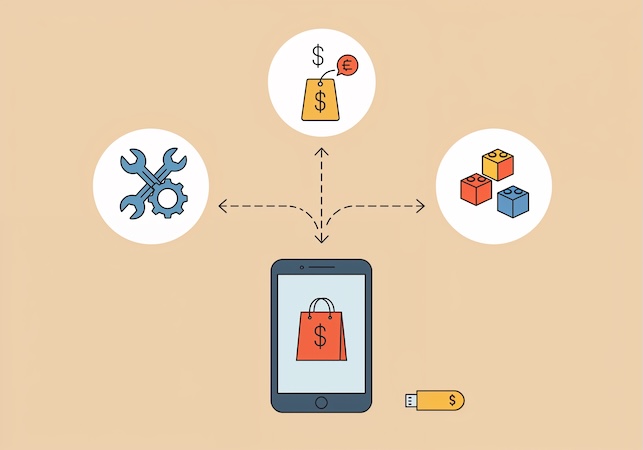
Quick calculus:
- Choose scratch build only if your board demands patent-grade IP and you’ve got a war chest.
- Opt for white-label when proving market fit trumps differentiation—but budget for the “rip-and-replace” once you outgrow the template.
- Go componentized when you need enterprise-grade compliance and a unique UX, minus the 18-month death march. Specode slots in like Lego Technic: boilerplate HIPAA plumbing pre-wired, your secret sauce snapped on top.
Whichever route you choose, vet any potential doctor on-demand app development company for audited HIPAA compliance, reusable modules, and a roadmap that won’t handcuff your product vision six months in.
Monetization & Business Models
If your app can’t make money while you sleep, you’ve built an expensive hobby. Below are the revenue levers our most successful clients yank—plus the landmines that trip up the rest.

During the early stages of on demand doctor app development, lock onto one of these models so your billing logic—and investor pitch—are wired for revenue from day one.
Payment processing is the silent hero (or villain) in every model. Lock in a HIPAA-capable processor that supports card-on-file tokenization and payer co-pay splits out of the box—otherwise you’ll bleed margin on manual billing fixes.
Bottom line: pick one core revenue engine early, validate it with real users, then layer on secondary streams only after unit economics look healthier than your average step count on Apple Health.
Feature Deep-Dive: Must-Have vs Next-Gen
Below is our reality-check list—stuff you absolutely need on Day 1 and the shiny upgrades that keep users coming back after the honeymoon period.
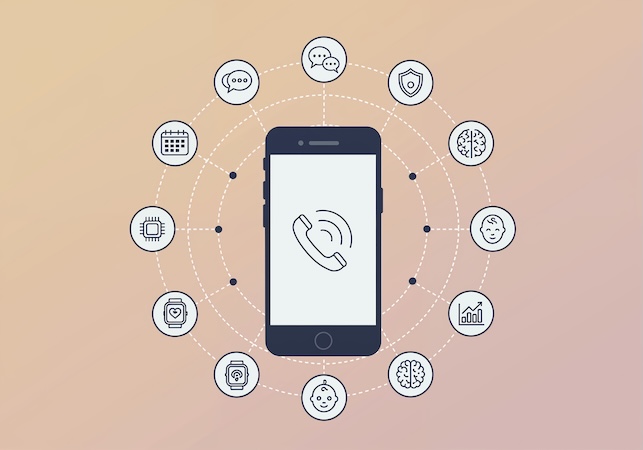
Whether you’re rolling your own code or partnering with doctor on demand app development services, here’s what absolutely has to ship on Day 1.
Must-Have (Don’t Ship Without ’Em)
Next-Gen (2025 and Beyond)
Ship the must-haves, then layer the next-gen pieces once usage metrics prove the core is sticky; that’s how you avoid the “all-features, no adoption” graveyard.
Regulatory Guardrails & Data Security by Design
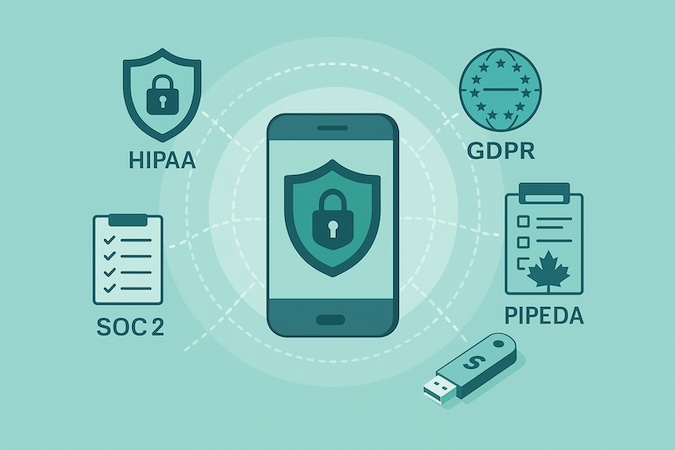
- Shift-left compliance. Map out every HIPAA, GDPR, PIPEDA, SOC 2, and state-specific healthcare regulations before the first line of code—retrofits cost 10× more. And yes, the same zero-tolerance playbook applies to doctor on call app development—no shortcuts just because response times are critical.
- Encrypt, log, and route wisely. Data should flow straight into the partner hospital’s electronic medical records, never a rogue CSV or junior dev’s laptop.
- Put clinicians in the war room. Pull medical professionals into threat-model sessions; they’ll spot workflow gaps that slip past engineers.
- Security drives revenue. Solid audit trails and identity proofing unlock value-based contracts tied to preventative care outcomes.
- Baseline, not bonus. Bullet-proof compliance is the foundation of modern healthcare applications development, not a line item in sprint 28.
Doctor On-Demand App Development Process & 8-Week Timeline
Specode’s “HIPAA-Ready MVP in 6–8 weeks” game plan shrinks the marathon of doctor appointment application development into a disciplined sprint. Whether you’re acting as a doctor on demand app creator in-house or leaning on our plug-and-play stack, the milestones stay the same.
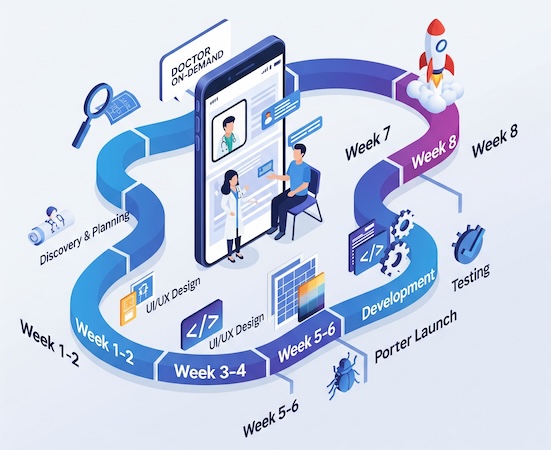
Week 1 – Discovery & Requirements
Workshop with founders and clinicians to create a living spec that anchors scope, compliance needs, and KPIs.
Week 2 – Component Mapping & Rapid Code Prototyping
Match ready-made scheduling, video, and auth modules to your workflow, then spin up clickable code stubs so doctors can poke at something real on day 10. Specode's AI builder will help you quickly spin up a prototype and preview it with your team.
Weeks 3-4 – HIPAA-Compliant Assembly & Custom Logic
Snap in boilerplate, layer the specialty features, and keep test coverage high; this is where differentiation happens without reinventing backend plumbing.
Week 5 – Integrations & Sandbox EHR Testing
Wire FHIR endpoints and run data-mapping scripts until bidirectional sync purrs—no PHI left behind.
Week 6 – Security Review & User Testing
Pen-test, remediate, and let a small clinician cohort thrash the build; capture every bug before real patients ever login.
Week 7 – Beta Launch & AI-Powered Analytics
Roll out to a limited geography, instrument core events (sessions, drop-offs, CSAT), and prep a feedback-driven backlog.
Week 8 – Continuous Compliance & Iteration
Close the feedback loop, ship hot-fixes, and prep the next feature wave—because velocity, not vanity features, wins this market. Iterate on UX, automate audit logs, and scope the next wave—think artificial intelligence triage or machine learning-powered personalization once the MVP proves its worth.
Eight weeks in, you’ve moved from whiteboard doodles to a production app you can demo to investors—or real patients—without sweating HIPAA audits.
On-demand Doctor App Development Cost
When you punch “telemedicine app development cost” into Google, you’ll find estimates ranging from a used-Honda to a Gulfstream. Here’s a saner benchmark, pulled from a couple of years of Specode bids and post-mortems:

- Bootstrap MVP — ≤ $80k
- Core video consults, scheduling, secure messaging
- Plug-and-play payment gateway, single-state compliance
- 6–8 week build; ideal for proving demand and courting seed investors
- Growth-Stage Build — ≈ $150k
- Multi-state provider licensure, EHR integrations, e-Rx, analytics
- Brand polish and patient onboarding automation
- 3–4 month roadmap; perfect for Series A decks and payer pilots
- National Roll-Out with AI & RPM — >$250 k
- Embedded AI triage, remote patient-monitoring dashboards, wearable sync
- High-availability infra, SOC 2 Type II, and 24/7 DevSecOps coverage
- 6-month phased launch across geographies and service lines
Reality check: Build price is only half the ledger. A seasoned doctor on demand app developer will remind you to budget for HIPAA hosting, annual SOC 2 audits, payer credentialing fees, and the ever-creeping cost of SMS/video bandwidth once user growth kicks in.
Hidden Pitfalls & How to Dodge Them
Even the slickest product vision can implode if you skip the unsexy details—lean on a seasoned doctor on demand app development company that’s already face-planted on these pitfalls and learned the fixes.

Licensure Roulette: 50 States, 50 Snares
Michigan’s pending exit from the Interstate Medical Licensure Compact proves the map can change mid-flight; Arkansas and Rhode Island are still “members-on-paper” with go-live dates in limbo. Relying solely on the IMLC can strand clinicians overnight.
Fix: run a dual track—compact where live, full licenses in hold-out states like California, and keep a lobbyist’s eye on withdrawal bills.
Credentialing Glacier: 120-Day Revenue Blackout
Commercial payers average 120-180 days to bless a new provider; every silent RFI adds weeks and burns $50-200 k in lost billings per head.
Fix: flawless CAQH hygiene, delegated credentialing where possible, and an API-fed tracker that pings payers every 10 days until approval hits the inbox.
Provider Burnout: When Flexibility Becomes Fatigue
Tele-docs still log 5.3 after-hours EHR hours per shift; replacement costs hit $250 k–$1 M per physician. Therapists on high-volume mental-health platforms feel the sting first.
Fix: bake AI scribes and team-based workflows into day-one ops—ROI lands 2-8× inside 18 months and slashes burnout up to 63 %.
Legacy-EHR Quicksand
FHIR version mismatches, real-time vitals drop-outs, and security-audit fails still derail integrations with Epic, Cerner, and Allscripts. A missed vitals feed can jeopardize a patient with a complex chronic condition—or trigger a six-figure breach penalty.
Fix: middleware that auto-translates DSTU2↔R4, ABR watchdogs on vitals, and pre-prod pentests before any PHI crosses the pipe.
WebRTC Meltdowns at Scale
TURN-server overloads and CG-NAT cellular dead-zones tank 1 in 5 video calls during Monday-morning surges; bandwidth bills spike too.
Fix: distributed SFU topology, autoscaled TURN over TLS 443, and real-time QoS analytics that reroute shaky sessions on the fly.
Quick-Start Playbook
- Track compact-instability bills quarterly; trigger license-gap workflows immediately.
- Stand up delegated-credentialing relationships before your first payer contract.
- Embed AI scribe pilots in sprint 1; measure burnout KPIs alongside RPM metrics.
- Mandate version-translation middleware in every EHR SOW.
- Stress-test TURN/SFU capacity at 2× your forecast peak—before launch day.
Dodge these five landmines early, and scaling nationwide feels less like whack-a-mole and more like chess.
How Specode Handles Doctor-On-Demand App Development
When your board wants traction yesterday, Specode swaps the 18-month agency slog for an 8-week fast-track. Our pre-vetted HIPAA components (video, scheduling, payments, EHR sync) plug together like Lego, letting your team focus on differentiation instead of boilerplate. Need proof?
- AlgoRX stood up a prescription-workflow platform—complete with eligibility checks and pharmacy routing—in under three months, all while staying HIPAA-aligned from day one.
- DyadSync went from requirements to pilot-ready in <30 days, giving freelance anesthesiologists a smart scheduling hub (chat, credentialing, Stripe payouts) without touching a single line of low-level auth code.
Healthcare AI Builder: From Prompt to Preview
Describe the flow—intake → eligibility → scheduling → messaging → billing—and watch it assemble with an instant preview. You start on healthcare rails (roles, consent, audit), fully brandable, so you’re shaping outcomes—not spelunking settings.
Pair chat-built assembly with custom code whenever you hit unique logic. Connect your own data early so screens and rules reflect real patients, payers, and providers. If you want an extra push, our Custom tier adds managed help and purpose-built AI agents. No AI magic—sequence and ruthless focus.
- Prompt → preview: update fields, branching, eligibility gates, alerts, and routing in seconds.
- Integration switchboard: EHR/EMR, pharmacy/eRx, labs, insurance eligibility, payments, telehealth—stitched into your flows.
- Guardrails: Change Log restore and role-scoped testing keep fast iteration safe.
- Full code ownership: export anytime; no lock-in.
Add the non-negotiables—SOC 2 logging, auto-scaled TURN servers, delegated credentialing hooks—and you’ve got a launch pad that ships features, not excuses. Hit the demo button and we’ll show how Specode collapses timelines, tames compliance, and future-proofs your on demand doctor application development strategy in one fell swoop.
Start free on Specode—shape your on-demand doctor app with the healthcare AI builder today, and bring us in later for EHR/eRx when you’re ready to scale.
Frequently asked questions
It’s a HIPAA-compliant mobile or web platform that matches patients with licensed clinicians for real-time video, voice, or chat visits. The app handles scheduling, triage, secure messaging, e-prescriptions, and payment—all routed through encrypted APIs so care happens anywhere, not just in a waiting room.
Front end: React Native or Flutter for cross-platform speed. Back end: Node.js or Go with a PostgreSQL/FHIR data layer. Real-time: WebRTC for video, MQTT/WebSockets for messaging. Cloud: AWS or GCP with HIPAA-eligible services (e.g., DynamoDB-on-KMS). Security: JWT + OAuth2, SOC 2 logging, automated CI/CD scans.
From scratch, 12–18 months is common. With a component-based approach like Specode’s, an MVP that passes compliance checks can ship in 8 weeks, then iterate.
Proven HIPAA/SOC 2 track record, reusable modules to cut timeline, in-house clinicians for workflow vetting, transparent pricing, and post-launch support that covers audits and scaling—not just coding.
White-label wins on speed and cost but limits feature control and branding. Custom builds offer full ownership and differentiation but take longer and cost more. A hybrid—white-label core plus custom add-ons—is often the sweet spot for Series A–ready startups.


